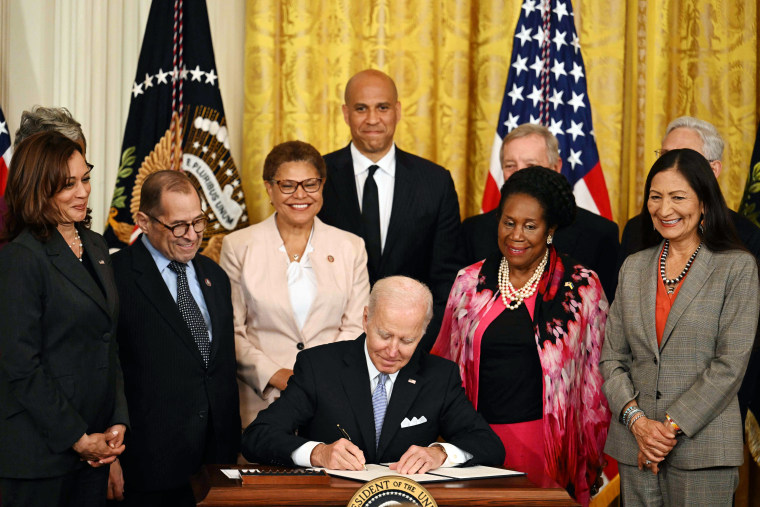In recognition of the two-year anniversary of the police murder of George Floyd, President Joe Biden on Wednesday signed an executive order to reform some aspects of federal law enforcement. In light of the breakdown of bipartisan congressional legislation to reform the police, Biden’s order is a small signal of recognition that something about policing needs to change.
Among other things, the order will direct federal law enforcement agencies to revise use-of-force policy, mandates the use of body-worn cameras, bans the use of dangerous tactics like chokeholds and restricts no-knock warrants, like the kind that police in Louisville, Kentucky, used when they killed Breonna Taylor, and increases Obama-era reforms that put restrictions on transferring military equipment to police.
History has taught us that, while policies may reduce some harm, they’re more of a symbol rather than a sign of any changes to the foundation of policing.
This order will also take a big step forward by creating a national registry of officers fired for misconduct and increasing transparency around policing. It also directs the National Academy of Sciences to conduct and publish a study of the civil liberties and racial justice impact of face-recognition technology and predictive policing algorithms, both of which municipalities around the country have already begun to ban for being invasive, dangerous and disproportionately affecting Black Americans.
But the problem is that history has taught us that, while policies may reduce some harm, they’re more of a symbol rather than a sign of any changes to the foundation of policing.
A few major problems would prevent these changes from having any real impact on the lives of people in the U.S. who live in fear of police violence. First, the executive order applies mainly to the more than 100,000 federal law enforcement officers. This is not insignificant, especially as federal law enforcement officers, like those of the Department of Homeland Security and Immigration and Customs Enforcement, have had increased their presence on the streets and at protests — but it’s still a far cry from reforms that would apply to the local, county and state police that most people deal with daily.
As part of the executive order, local and state police would also be incentivized to make policy reforms in exchange for grant funding, which history has shown often goes toward buying invasive surveillance technologies.
Policing cannot be simply reformed by policy. Unfortunately, policy on the books often means very little on the ground. As a saying from the New York City Police Department in the late 19th and early 20th century goes, “There is more law at the end of a policeman’s nightstick than in a decision of the Supreme Court.” This quote exemplifies a major problem: Policing on the ground is often spontaneous and unsupervised, and in those moments, police have proven time and time again that a policy written on a piece of paper somewhere rarely has an effect on how officers do their job. Chokeholds, a problem Biden’s executive order hopes to address with restrictions, highlights a major window into this problem. In some cities, bans on the police use of chokeholds have been in place for decades, but it does not stop police from using them and people from dying from them.
As has been argued many times by activists and academics, one of the key ways to lessen the harm that policing has on communities is simply to limit the number of daily interactions people have with police. You do that by limiting the number of police, taking away responsibilities from departments, or both, and many more options. To that end, the executive order shows a glimmer of hope in a commitment to identify federal resources for “alternative responder models.” Hopefully, this means more nonpolicing support for response teams popping up around the country, teams that send unarmed professionals to respond to calls pertaining to unhoused people or people in the midst of a mental health crisis — rather than armed officers who may escalate the situation.
Worth noting is that when an earlier draft of Biden’s executive order leaked in January, some police were furious that its preamble mentioned the relationship between policing and “systematic racism,” saying that it meant Biden would be “turning his back on police.”
This rift caused the Biden administration to seek more input from police groups. It’s a small consolation that the fact sheet of the executive order still mentions systematic racism, which, in combination with the reforms listed, seems to have already angered some police groups. In an era in which the mayor of San Francisco plans to skip the city’s Pride parade because police feel slighted by new policies, or police unions tell then-New York City Mayor Bill de Blasio that he threw police “under the bus” when he merely mentioned his anxieties over interactions his biracial son could have with officers, it’s increasingly rare to see moderate politicians do anything to incur the ire of the police.
The police in the United States is a large, massively funded, unwieldy and politically powerful faction. In some places, their traditions and cultures go back centuries, perpetuated and preserved by institutional memory, legal and social insulation, a monopoly on violence and an expectation of servility in the people they encounter. Taking away some of their most dangerous tools and tactics on paper is a step forward, but it is a tenuous step, one easily countered by the realities of how officers do their jobs — and by the shifting political tides that could reverse this executive order in an instant.
